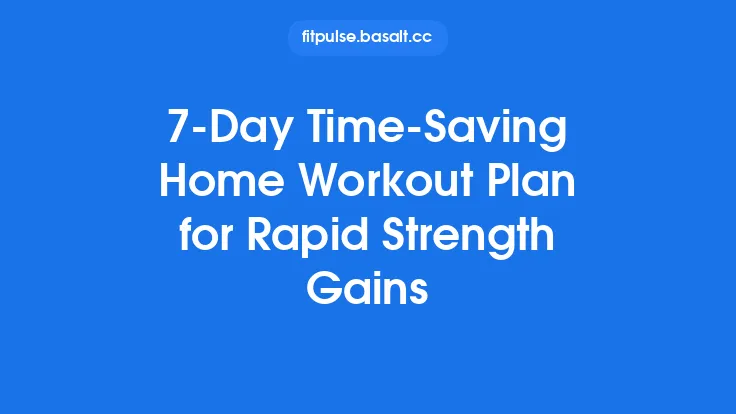Fast‑track leg day doesn’t have to be a marathon. In just twelve minutes you can hit every major muscle group of the lower body, boost neuromuscular activation, and lay the groundwork for strength and hypertrophy gains—all from the comfort of your living room. This guide walks you through the science, the structure, and the practical details you need to make a concise, effective leg workout a permanent fixture in your home‑training arsenal.
Why a 12‑Minute Leg Routine Works
1. Time‑under‑tension matters more than total volume
Research on resistance training consistently shows that the amount of time a muscle spends under load (time‑under‑tension, or TUT) is a primary driver of strength and hypertrophy adaptations. A focused 12‑minute block can deliver sufficient TUT if you keep rest intervals short and maintain a moderate‑to‑high tempo.
2. Neuromuscular priming
Short, intense bouts of lower‑body work stimulate the central nervous system (CNS) to recruit high‑threshold motor units. This “neural boost” carries over to longer sessions later in the week, improving overall performance.
3. Hormonal response
Even brief, compound‑heavy leg work triggers an acute rise in anabolic hormones (testosterone, growth hormone). While the magnitude is smaller than a 60‑minute session, the cumulative effect of multiple short sessions can be comparable when training frequency is high.
4. Adherence advantage
Behavioral science tells us that perceived effort and time commitment are the biggest barriers to consistency. A 12‑minute routine fits easily into most daily schedules, dramatically increasing the likelihood of long‑term adherence.
Essential Equipment and Space Requirements
| Item | Why It’s Needed | Alternatives |
|---|---|---|
| Sturdy chair or bench | Provides a stable platform for step‑ups and Bulgarian split squats | A low coffee table, sturdy box, or a stack of books |
| Resistance band (medium‑heavy) | Adds progressive overload for glutes, hamstrings, and hips | A backpack filled with books, a kettlebell, or a dumbbell if available |
| Non‑slip mat or rug | Protects joints and prevents slipping during jumps | A folded towel or yoga mat |
| Stopwatch or timer app | Ensures precise interval work | Phone’s built‑in clock, a kitchen timer |
A clear 3‑by‑3‑meter (≈10‑by‑10‑ft) area is sufficient. Keep the space free of tripping hazards and ensure good ventilation.
Anatomy of a Balanced Lower‑Body Session
A well‑rounded leg workout should address three functional pillars:
- Posterior Chain – glutes, hamstrings, calves, and lower back.
- Anterior Chain – quadriceps, hip flexors, and core stabilizers.
- Lateral/Rotational Stability – abductors, adductors, and hip rotators.
By selecting exercises that hit each pillar, you avoid muscular imbalances that can lead to injury or plateau.
The 12‑Minute Protocol: Exercise Selection and Timing
The routine follows a circuit format: perform each movement for a set work interval, transition quickly to the next, and repeat the circuit twice. Total time = 2 rounds × (5 exercises × 45 s work + 15 s transition) + 30 s warm‑up + 30 s cool‑down ≈ 12 minutes.
| Exercise | Target Muscles | Work (seconds) | Transition (seconds) | Notes |
|---|---|---|---|---|
| 1. Bodyweight Squat to Pulse | Quads, glutes, core | 45 | 15 | Drop into a full squat, rise halfway, pulse for the last 15 s. |
| 2. Reverse Lunge with Band‑Assisted Hip Extension | Glutes, hamstrings, hip extensors | 45 | 15 | Step back into a lunge; at the top, press the band forward to activate the glute. |
| 3. Single‑Leg Romanian Deadlift (RDL) – Alternating | Hamstrings, glutes, balance | 45 | 15 | Use the band for light resistance; keep a slight knee bend. |
| 4. Bulgarian Split Squat (Feet on Chair) | Quads, glutes, stabilizers | 45 | 15 | Keep torso upright; drive through the front heel. |
| 5. Calf‑Focused Jump‑Squat | Calves, quads, power | 45 | 15 | Land softly, immediately explode upward; focus on ankle extension. |
Warm‑up (30 s) – March in place, dynamic hip circles, and ankle rolls.
Cool‑down (30 s) – Standing quad stretch and calf stretch, each held for 15 s.
Tempo guidelines
- Concentric (upward) phase: Explosive, 0.5 s.
- Eccentric (downward) phase: Controlled, 1.5 s.
- Isometric hold/pulse: As indicated.
Progression options
- Increase band tension or add a weighted backpack (5–10 lb).
- Extend work intervals to 55 s while keeping transitions at 15 s.
- Add a third round for advanced trainees (≈18 min total).
Progression and Scaling Strategies
| Goal | Adjustment | Example |
|---|---|---|
| Strength focus | Add external load, reduce reps, increase rest between rounds | 10 lb backpack, 3 × 10‑second rest between rounds |
| Hypertrophy focus | Increase time under tension, incorporate slow eccentrics | 3 s eccentric, 1 s pause at bottom |
| Endurance focus | Shorten rest, keep band light, add a third circuit | 12 s transition, 3 rounds |
| Mobility focus | Replace jump‑squat with lateral step‑over, add hip‑openers | Lateral band walk for 45 s, finish with 30 s pigeon stretch |
Track the variable you’re targeting (load, tempo, volume) each session to ensure progressive overload.
Safety Tips and Common Mistakes
- Maintain neutral spine during RDLs and split squats; avoid rounding the lower back.
- Knee tracking – knees should stay in line with the second toe; prevent valgus collapse.
- Foot placement – keep weight evenly distributed across the foot, especially during calf‑focused jumps.
- Band anchoring – ensure the band is securely looped around a stable object or your feet to avoid snap‑back injuries.
- Breathing – exhale on the concentric (upward) phase, inhale on the eccentric (downward) phase.
Common pitfalls include rushing transitions (leading to poor form), using a band that’s too light (diminishing stimulus), and neglecting the warm‑up, which can increase joint stiffness.
Integrating the Session into a Weekly Plan
| Day | Focus | Sample Layout |
|---|---|---|
| Monday | Lower‑body power | 12‑min leg circuit + 10 min plyometric drills |
| Tuesday | Upper‑body push | Separate routine (e.g., push‑ups, rows) |
| Wednesday | Active recovery | Mobility flow, light cardio |
| Thursday | Lower‑body endurance | 12‑min leg circuit (lighter band) + 10 min steady‑state cardio |
| Friday | Full‑body strength | Compound lifts (if equipment available) |
| Saturday | Lower‑body strength | 12‑min leg circuit (heavier band) + optional accessory work |
| Sunday | Rest or gentle stretch | 15‑min mobility routine |
By spacing the leg circuit 2–3 times per week, you hit each muscle group with sufficient frequency while allowing recovery.
Tracking Results and Staying Motivated
- Log the variables – load (band tension or weight), work interval, rest, and perceived exertion (RPE 1‑10).
- Monthly performance test – record the maximum number of quality repetitions you can complete in a 45‑second squat pulse. Aim for a 5‑10 % improvement each month.
- Visual cues – place a timer on the fridge or set a recurring phone alarm labeled “Leg Day Sprint.”
- Reward system – after four consecutive weeks of completing the protocol, treat yourself to new workout gear or a recovery tool (foam roller, massage gun).
Consistency beats perfection; the brevity of the routine makes it easier to stay on track.
Bottom Line
A 12‑minute lower‑body workout is a scientifically sound, highly efficient method to develop leg strength, muscle tone, and functional power without sacrificing precious time. By focusing on compound movements, maintaining tight work‑to‑rest ratios, and progressively overloading with bands or household weight, you can achieve lasting results from a modest living‑room setup. Stick to the protocol, respect form, and track your progress—your legs will thank you, and you’ll have reclaimed valuable minutes in your day.





